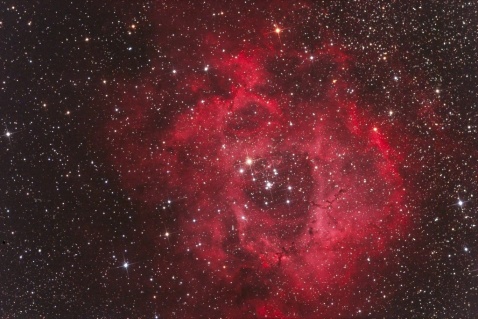(单词翻译:单击)
Hubble realized that this could be expressed with a simple equation, Ho = v/d (where Ho is the constant, v is the recessional velocity of a flying galaxy, andd its distance away from us). Ho has been known ever since as the Hubble constant and the whole as Hubble's Law. Using his formula, Hubble calculated that the universe was about two billion years old, which was a little awkward because even by the late 1920s it was fairly obvious that many things within the universe— not least Earth itself—were probably older than that. Refining this figure has been an ongoing preoccupation of cosmology.
哈勃发现,这可以用个简单的等式来加以表示:Ho=v/d(Ho是常数,v是星系飞离的速度,d是它离开我们的距离)。自那以后,Ho一直被称之为哈勃常数,整个等式被称之为哈勃定律。哈勃利用自己的等式,计算出宇宙的年龄大约为20亿年。这个数字有点儿别扭,因为即使到20世纪20年代末,情况已经越来越明显,宇宙里的许多东西──很可能包括地球本身──的年龄都要比它大。完善这个数字是宇宙学界一直关心的事情。
Almost the only thing constant about the Hubble constant has been the amount of disagreement over what value to give it. In 1956, astronomers discovered that Cepheid variables were more variable than they had thought; they came in two varieties, not one. This allowed them to rework their calculations and come up with a new age for the universe of from 7 to 20 billion years—not terribly precise, but at least old enough, at last, to embrace the formation of the Earth.
关于哈勃常数,惟一常年不变的是对它的评价意见不一。1956年,天文学家们发现,造父变星比他们认为的还要变化多端;造父变星可以分为两类,而不是一类。于是,他们重新进行计算,得出宇宙新的年龄大约为70亿年到200亿年──不是特别精确,但至少相当古老,终于可以把地球的形成涵盖其中。
In the years that followed there erupted a long-running dispute between Allan Sandage, heir to Hubble at Mount Wilson, and Gerard de Vaucouleurs, a French-born astronomer based at the University of Texas. Sandage, after years of careful calculations, arrived at a value for the Hubble constant of 50, giving the universe an age of 20 billion years. De Vaucouleurs was equally certain that the Hubble constant was 100.
在此后的几年里,爆发了一场旷日持久的争论,一方是哈勃在威尔逊山天文台的继承人阿伦·桑德奇,另一方是法国出生的、得克萨斯大学的天文学家热拉尔·德·沃库勒。桑德奇经过几年的精心计算以后,得出哈勃常数的值为50,宇宙的年龄为200亿年。沃库勒同样很有把握,哈勃常数为100。


